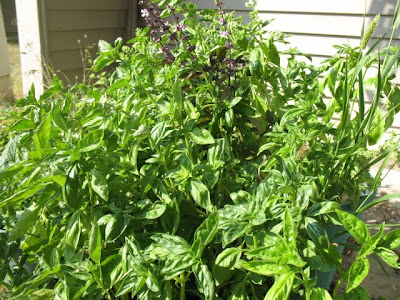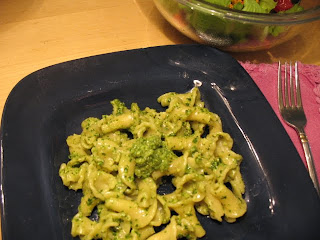 I always have an orderly rank of recipes lined up, eagerly waiting to volunteer their services to the tomatoes that come in July and August. I can hardly wait to make Gazpacho. I always hope the basil in the containers on my porch will be ready when the first cherry tomatoes are in the CSA box so I can make Pasta with Cherry Tomatoes, Olives and Basil. Sandwiches and salads benefit from that sweet-tart and juicy boost that can only come from ripe seasonal tomatoes. When it gets to September, however, I want something different. Even if it hasn’t started to get cold yet (for the record, it just did), the days are noticeably shorter, the breezes a little cooler, and warmer food somehow beckons more forcefully than cold soups.
I always have an orderly rank of recipes lined up, eagerly waiting to volunteer their services to the tomatoes that come in July and August. I can hardly wait to make Gazpacho. I always hope the basil in the containers on my porch will be ready when the first cherry tomatoes are in the CSA box so I can make Pasta with Cherry Tomatoes, Olives and Basil. Sandwiches and salads benefit from that sweet-tart and juicy boost that can only come from ripe seasonal tomatoes. When it gets to September, however, I want something different. Even if it hasn’t started to get cold yet (for the record, it just did), the days are noticeably shorter, the breezes a little cooler, and warmer food somehow beckons more forcefully than cold soups.
When I got a gift of beautiful heirloom tomatoes from my friends Jen and Jake (I do believe Jen is the gardener) a little while back, I wanted to do something particularly nice with them. I knew I was probably going to make a sauce or salsa or something out of many of them, just because it would be hard for even me, a great lover of tomatoes, to just eat them all fresh, much as I wanted to.
After I’d been shopping for the week, I remembered this great recipe for a tomato and beef stir fry I had copied from a cookbook by Martin Yan way back when. In fact, the when was so way back that I had never made this dish for Harry, at least not that either of us could remember, and I’ve known him for 12 years. Luckily, I had just bought some steak for Harry, so I happened to have what I needed for the recipe. It was a New York strip steak, which is pretty
 fancy for stir fry. Normally, I would use flank steak, sirloin, or even round steak for stir frying, cutting it across the grain to ensure more tenderness in the final product (the shorter fibers result in easier, more pleasant chewing). I have to say, the strip steak was super tender in this dish, and since the recipe doesn’t use much beef, a more expensive cut is still reasonably economical. Use what you like or what you have.
fancy for stir fry. Normally, I would use flank steak, sirloin, or even round steak for stir frying, cutting it across the grain to ensure more tenderness in the final product (the shorter fibers result in easier, more pleasant chewing). I have to say, the strip steak was super tender in this dish, and since the recipe doesn’t use much beef, a more expensive cut is still reasonably economical. Use what you like or what you have.I made a few other changes to the original recipe that also reflected what I happened to have in my pantry at the time, plus I increased the amount of tomatoes. For me, it was all about the tomatoes. The final dish had the consistency of a stew, and, if you didn’t feel like messing with rice or noodles, or if your cupboard was bare of such starches, you could serve this like a stew. I served it over brown rice, which soaked up the savory sauce. The complex flavors of the perfect heirloom tomatoes worked and played extremely well with the soy sauce and vinegar. Harry said the flavors oscillated on the tongue. I needn’t say more than that.

Tomato and Beef Stir Fry
Based on a recipe by Martin Yan
2 tablespoons soy sauce
2 tablespoons Shaoxing wine or dry sherry
2 tsp cornstarch
¾ lb beef steak, such as flank steak, sirloin, round steak (or whatever you like), thinly sliced across the grain
¼ cup ketchup
2 tablespoons soy sauce
2 tablespoons rice vinegar
1 tablespoon chile garlic sauce
1 teaspoon sesame oil
2 teaspoons sugar
2 tablespoons vegetable or peanut oil, divided
1 tablespoon minced garlic
1 small onion, chopped (about 1-inch pieces)
1 cup green bell pepper, chopped (about 1-inch pieces)
4 cups tomato cut into wedges (about 3 large tomatoes
2 teaspoons cornstarch
2 tablespoons water

1. Combine 2 tablespoons soy sauce, dry sherry and 2 tsp cornstarch in a medium bowl. Add the sliced steak and stir to coat evenly. Set aside about 30 minutes (you can prepare the rest of the ingredients and any accompaniments during this time).
2. Combine the ketchup, 2 tablespoons soy sauce, rice vinegar, chile garlic sauce, sesame oil and sugar in a medium bowl to make a sauce. Set aside.
3. Heat a wok or large skillet with 1 tablespoon vegetable or peanut oil over high heat. Remove the beef from the marinade with a slotted spoon and add it to the hot oil. Stir fry about 2 minutes or until beef is evenly browned. Remove beef from the pan and set aside in a clean bowl or plate.
4. Add remaining 1 tablespoon vegetable or peanut oil to the pan. Add the onion and bell pepper. Stir fry about 2 minutes or until the vegetables soften somewhat and the onion begins to brown. Add the garlic and cook 30 seconds.
5. Add the tomatoes and the sauce and mix well. Cook about 1 minute.
6. Combine 2 teaspoons cornstarch and 2 tablespoons water and mix well. Add to the wok along with the cooked beef. Cook and stir until the sauce boils and thickens.






























 And so “tailgate food” is what we affectionately call our Sunday afternoon fare during football season: bratwurst and hamburgers on the grill, potato salad, barbecued chicken and pork, baked beans, chili. And then there are the many snacks and finger foods that make this time of year so blessed, like bean dip.
And so “tailgate food” is what we affectionately call our Sunday afternoon fare during football season: bratwurst and hamburgers on the grill, potato salad, barbecued chicken and pork, baked beans, chili. And then there are the many snacks and finger foods that make this time of year so blessed, like bean dip.















